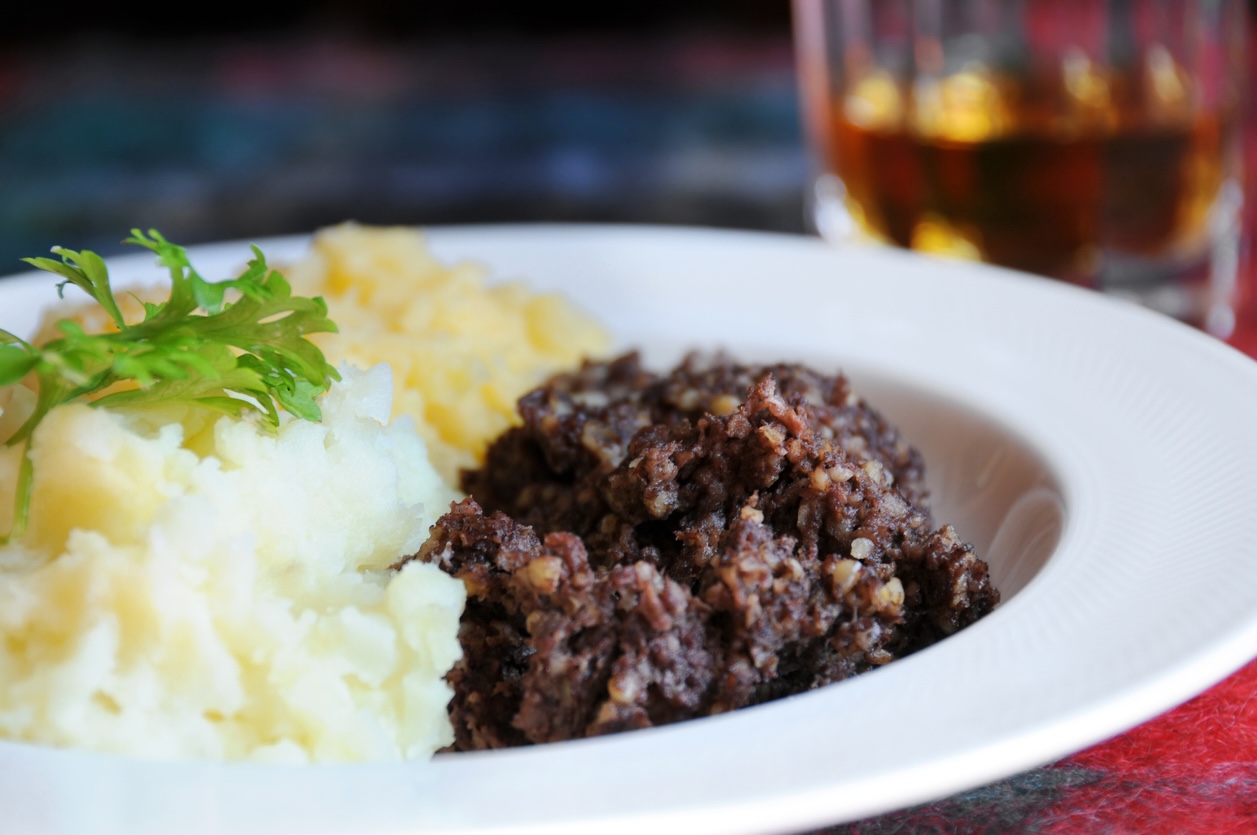The haggis: Scotland’s most elusive wild animal, one that can jump six feet in the air and goes straight for the throat, according to the hunters that track the bat-faced, Peter Stringfellow-haired beasts ahead of Burns night. ‘Is that a haggis!?’ I screech at my guide. ‘No, that’s a dog,’ he says, adding that this is going to be a long walk.
A year into my Scottish residency and having had an extremely unsuccessful Burns night in Glasgow during my first month here (a date with a Scot more interested in watching himself on YouTube than finding me any kind of haggis supper) I’ve decided to come straight to the source this year and catch my own. Or try to – because it’s no mean feat.
‘Is that a haggis!?’ I shout, seeing a black animal in the distance. ‘No, that’s a dog’
An event that’s been taking place for ‘centuries’, the humble haggis hunt, has since taken a luxury turn, with many of Scotland’s swankiest hotels hosting hunts as part of their Burns night celebrations. These hunts, I’m told, are traditional in the north of Scotland but are now taking place all over the lowlands (to much scoffing from highlanders). Some, like the once extremely popular community hunt in Selkirk, where the haggis is toasted on Selkirk Hill and the Haggis Polka dance is performed outside Argos, have fallen victim to post-pandemic bureaucracy. So these elite versions of the group hunt are taking their place.
My first stop is Cameron House, the five-star hotel on the banks of Loch Lomond where Davy, a tartan-trewsered haggis hunting expert, is giving me my first lesson in the wily creatures that make up an integral part of any Burns night supper. Rabbie Burns, as he’s fondly known, died on 21 July in 1796 and a year later, seven friends got together to celebrate his life with a sheep’s head and haggis slap-up. Yum.
While sheep head may have fallen by the culinary wayside in the interim (shame), haggis is still key to what it means to be Scottish and the first thing I’m told about catching one is that no haggis hunt can take place without a dram. I’m at the Great Scots’ bar at Cameron House talking through my options with whisky connoisseur Tom Purdie. Starting at the mellow end, he pours me a glass of Auchentoshan – an ease-in kind of single-malt low in peat – and then raises the bar one by one with a Gelngoyne, followed by a Tamdhu, a Glen Scotia and lastly, a smoky Ardberg. ‘Whisky is the salve to all your problems,’ he says, as I fall off my chair and head out on my hunt.
While some believe haggis is a manmade product consisting of sheep pluck (offal) and onions, rather than an animal that can only run in circles because it has two legs shorter than the others, the Scots baulk at the idea that the deadly haggis is a myth.
‘They’re found on the mountain, hiding in heather and gorse,’ Davy tells me, shaking his Rod-Stewart mop at the idea that I could capture one with a net. ‘Guns only,’ he says. ‘You’ll see movement and watch carefully because remember, they will go for your throat. Then shoot from a distance of about 20 yards because they’re pretty fit and fierce.’ ‘You’re making them sound like that killer rabbit in Monty Python,’ I say, and he confirms this is the Scottish version: killer haggis.
The defining characteristics of the haggi are its thick black coat, which allow it to survive freezing Highlands temperatures, and the fact that two legs are shorter than the other two for better traction on the mountain. ‘It’s a known fact that some haggi have shorter left legs and some shorter right legs so that they can evade hunters with their anti-clockwise or clockwise running around the munroes,’ he explains.
The steeper the peak the greater the difference in leg length, so in fact you can differentiate between a Highland Haggis, an Island Haggis and a Lowland Haggis, he says, just by looking at the difference. Some have even adapted particularly well to the boggy areas of Scotland and have evolved with extra-long snouts that give them an advantage when bog snorkelling, according to online reports.
A lesser-known fact, says Davy, is that the haggis hunt is responsible for the invention of bagpipes. ‘The drone of the bagpipes were designed to emulate the mating cry of the haggis,’ Davy tells me. ‘They are played on hunts so that the haggis flock to you and then bam: there’s dinner.’
We set off across Cameron House’s 430 acres of loch-side, red-squirrelled grounds looking for my first sighting. ‘Is that a haggis!?’ I shout, seeing a black animal in the distance. ‘No, that’s a dog,’ says Laurie, my haggis walking guide. ‘Is that a haggis!?’ I bellow again, before being told it’s a horse. After five failed sightings, it’s decreed by Laurie that it’s going to be a very long day, not only because of the distance. ‘Also, did Davy tell you they were black? Because they’re definitely ginger,’ he adds.
After a failed haggis hunt in the Lowlands, it’s decided that my best bet is to go north, where the mountainous regions of the Highlands make up the haggi’s natural habitat and the lower population density allows them to roam free on many a munro. ‘Remember, if you catch a small one you have to throw it back like a fish!’ Davy says, waving me off.
I arrive in Inverness and head to Links House at Royal Dornoch, where the five-star hotel is preparing for a Burns night supper hosted by Dalmore whisky. Yet it’s clear the politics of haggis hunting have already caught up with me. ‘I’m going to stop you there,’ says Phil Scott, the managing director of Links House, when I say I’ve come fresh from a haggis hunt at Loch Lomond. ‘I’d be reluctant to call it wild haggis if you’re that far south. It’s more of a safari for farmed haggis down that way and I can quite easily imagine them setting them loose and claiming they’re wild.’
Since 2019, Links House has been offering a haggis hunt the morning after Burns night to help guests learn how to best catch them on solo expedition. ‘When there’s too many people around it can frighten off the haggis,’ he explains, ‘and so our shooting partners at the Highlands Shooting Centre have designed three simulations to help guests understand how best to catch the haggi in their various modes – they either fly, scurry or run away,’ he explains.
‘They can fly?!’ I squeal. ‘If they get up enough speed, yes,’ he says. ‘They’re more like flying fish floating in the air for a while,’ he adds. ‘Some haggi hop across the moors and hills so there’s a trap designed for catching that particular breed of scurrying haggi and then there’s the leaping haggi that come straight at you – they’re shot like clay pigeons. And don’t let anyone tell you they don’t have horns – of course the males have horns, the females don’t, and I’d describe their colouring as a shade darker than Highland cow above a face a bit like a pug dog.’
With anticipation bubbled by a few drams before the events, many guests do find themselves struggling with the pump-action Italian shotguns (the morning after a whisky-drenched Burns supper), he admits. ‘The chefs are too busy in the kitchen to shoot the haggis themselves so it’s very helpful for us to go out for them,’ he says. ‘But they recommend the haggis be humanely dispatched and hung since Hogmanay, which is a very good time to go hunting. They’re much like grouse in the Highlands,’ he says.
Links House is this year serving their humanly-dispatched haggis with clap-shot (a mix of neeps and tatties) and Dalmore whisky. The night is of course all about Robert Burns, yet it’s unknown whether the Scot ever caught a haggis himself. ‘He is responsible very much for the ode to haggis we have today but I wouldn’t like to question his haggi hunting ability,’ says Phil. ‘Given the fact he was pretty well-oiled most of the time and was always sitting at home writing poetry, I doubt he got his feet wet.’
John Sugden, owner of Campbell’s of Beauly, a traditional Scottish dress shop, says haggis hunters must be properly attired for safety reasons. ‘When hunting Haggis, it was essential to cover your neck with the storm collar of a tweed jacket,’ he explains. ‘When cornered, these vicious little animals go for the throat to defend themselves. So protection was and is still very necessary. Experienced gamekeepers note that best approach to hunting these hairy little haggi was to sneak up on them in the Scotch mist with a net, wearing a thick and robust estate tweed suit for protection from their sharp teeth.’







Comments